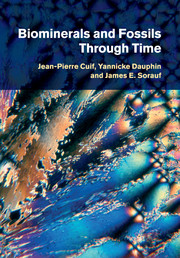Book contents
- Frontmatter
- Contents
- Preface
- Introduction: Milestones in the study of biominerals
- 1 The concept of microstructural sequence exemplified by mollusc shells and coral skeletons
- 2 Compositional data on mollusc shells and coral skeletons
- 3 Origin of microstructural diversity
- 4 Diversity of structural patterns and growth modes in skeletal Ca-carbonate of some plants and animals
- 5 Connecting the Layered Growth and Crystallization model to chemical and physiological approaches
- 6 Microcrystalline and amorphous biominerals in bones, teeth, and siliceous structures
- 7 Collecting better data from the fossil record through the critical analysis of fossilized biominerals
- 8 Results and perspectives
- List of references
- Name index
- Subject index
7 - Collecting better data from the fossil record through the critical analysis of fossilized biominerals
Case studies ranging from the interpretation of individual samples to the distribution of fossils through time
Published online by Cambridge University Press: 10 January 2011
- Frontmatter
- Contents
- Preface
- Introduction: Milestones in the study of biominerals
- 1 The concept of microstructural sequence exemplified by mollusc shells and coral skeletons
- 2 Compositional data on mollusc shells and coral skeletons
- 3 Origin of microstructural diversity
- 4 Diversity of structural patterns and growth modes in skeletal Ca-carbonate of some plants and animals
- 5 Connecting the Layered Growth and Crystallization model to chemical and physiological approaches
- 6 Microcrystalline and amorphous biominerals in bones, teeth, and siliceous structures
- 7 Collecting better data from the fossil record through the critical analysis of fossilized biominerals
- 8 Results and perspectives
- List of references
- Name index
- Subject index
Summary
Any improvement in our knowledge of the mineral structures formed by living organisms contributes to a more accurate analysis of their fossil remains. Such a simple remark is important, because selection of the methods used for assessing the preservation of any fossil, as well as interpretation of numerical values resulting from measurements carried out on fossil material, depends heavily on concepts regarding its original state and mode of growth. In corals, for instance, the amount of confidence in the reliability of isotopic or chemical measurements has long been based on a simple X-ray diffraction diagram, owing to postulation of a purely mineral composition of these “physiochemically” crystallized materials.
As defined by Berner (1980) the term “diagenesis,” as applied to any sedimentary object, refers to “the sum total of processes that produce changes – mineralogical, chemical and physical – from the time of deposition.” Such an extensive definition (see also Bates and Jackson 1980) obviously includes fossilization, the term we use when sedimentary processes are modifying materials that have been formed by living organisms. From this standpoint, the methods by which the three major biomineralization mechanisms control the deposition of their mineralized structures allow us to assume that diagenesis of the resulting materials will follow very different and specific pathways. A major difference from chemically precipitated crystals is that biominerals exhibit very distinct structural parameters at the micrometer and submicrometer scales, even if the chemical compositions of their mineral parts do not greatly differ from purely chemical equivalents.
- Type
- Chapter
- Information
- Biominerals and Fossils Through Time , pp. 349 - 434Publisher: Cambridge University PressPrint publication year: 2010



